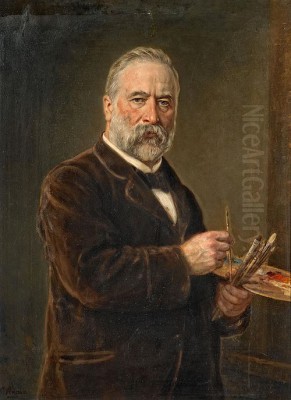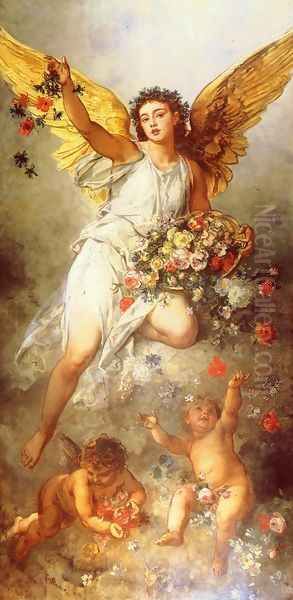
Ludwig Knaus stands as a significant figure in 19th-century German art, celebrated primarily for his mastery of genre painting and his influential role within the Düsseldorf School. Born in Wiesbaden, Germany, on October 5, 1829, and passing away in Berlin on December 7, 1910, Knaus's long and productive career left an indelible mark on the artistic landscape of his time. His works, characterized by meticulous detail, keen observation of everyday life, and a warm sense of humanity, captured the spirit of rural and bourgeois Germany, earning him widespread acclaim both domestically and internationally.
Early Life and Artistic Formation
Ludwig Knaus hailed from a background not immediately connected to the fine arts; his father was an optician in Wiesbaden. Despite this, young Ludwig displayed artistic inclinations early on. Recognizing his talent, he pursued formal training, enrolling at the prestigious Kunstakademie Düsseldorf (Düsseldorf Art Academy) from 1845 to 1848. This period was crucial for his development, placing him at the heart of one of Germany's most important artistic centers.
At the Academy, Knaus studied under influential figures who shaped the direction of the Düsseldorf School. Key among his instructors were Wilhelm von Schadow and Karl Ferdinand Sohn. These teachers instilled in him the rigorous academic training characteristic of the school, emphasizing strong drawing skills, careful composition, and a tendency towards narrative clarity. The Düsseldorf School itself was known for its detailed realism, often applied to historical subjects, landscapes, and, significantly for Knaus, genre scenes depicting the lives of ordinary people.
The environment at the Academy provided Knaus not only with technical skills but also with exposure to the prevailing artistic currents and fellow aspiring artists. This foundational period grounded him in the German artistic tradition while setting the stage for his later evolution and international experiences. His early works already hinted at his preference for observing and depicting human interactions and daily routines.
Parisian Influence and Stylistic Development

Seeking broader horizons and exposure to different artistic approaches, Knaus traveled beyond Germany. A pivotal period was spent in Paris between 1852 and 1860. This immersion in the French art capital was transformative. He studied with the prominent French painter Thomas Couture, known for his own blend of academic technique and romantic sensibility. Couture's influence likely encouraged Knaus to explore freer brushwork and perhaps a richer palette, absorbing the latest techniques circulating in Paris.
However, Knaus did not simply adopt French styles wholesale. While his time in Paris undoubtedly refined his technique and broadened his perspective, he integrated these new influences with his German training and sensibilities. He maintained a commitment to detailed observation and narrative content, hallmarks of the Düsseldorf tradition. His exposure to French art, possibly including early realist currents and the precursors to Impressionism, added a layer of sophistication to his work without sacrificing its essential character.
During this phase, Knaus also looked to historical precedents. Echoes of 17th-century Dutch and Flemish masters, renowned for their own intimate genre scenes and technical polish, can be discerned in his developing style. He synthesized these various influences – German academicism, Parisian modernity, and Northern European tradition – to forge a distinctive artistic voice. His paintings began to exhibit the qualities that would define his mature work: technical virtuosity, psychological insight, and an engaging, often gently humorous, portrayal of human life.
The Düsseldorf School and the Art of Genre
Ludwig Knaus is inextricably linked with the Düsseldorf School, not just as a student but as one of its leading exponents, particularly in the field of genre painting. Genre painting, depicting scenes of everyday life, rose to prominence in the 19th century, offering an alternative to the grand narratives of history painting or the formalities of portraiture. It allowed artists to explore the customs, activities, and social dynamics of contemporary society.
Knaus excelled in this domain. His approach was characterized by meticulous research and observation. He often traveled to rural areas, particularly in the Black Forest and other regions of Germany, studying local customs, dress, and environments firsthand. This dedication to authenticity lent credibility and charm to his depictions of peasant life, village festivals, domestic interiors, and childhood scenes.

His paintings often tell a story, capturing a specific moment rich with implied narrative and emotional content. He possessed a remarkable ability to render textures, fabrics, and facial expressions with convincing realism. Yet, his realism was often tempered with a degree of idealization and sentimentality, aligning with the tastes of the Biedermeier era and the later 19th century. His works resonated with a bourgeois audience who appreciated the charming, orderly, and often picturesque view of rural and family life he presented. Within the Düsseldorf School, his focus on genre distinguished him, and his success helped elevate the status of this type of painting in Germany.
Themes and Major Works
Throughout his career, Ludwig Knaus explored several recurring themes, primarily centered around human experience. Rural life was a dominant subject, with countless depictions of farmers, village gatherings, and rustic interiors. Children were another favorite theme, portrayed with sensitivity and often a touch of playful humor. He captured the innocence, mischief, and social interactions of childhood in works that proved immensely popular.
His oeuvre includes numerous celebrated paintings. Girl in a Field (1857), now housed in the Hermitage Museum, is a classic example of his sensitive portrayal of youth in a natural setting. The Golden Wedding, a work highly acclaimed in its time, reportedly won a Grand Gold Medal in Paris and was said to have been acquired by the Louvre, showcasing his ability to depict significant life milestones with warmth and detail.
Morning after Kermess earned him a second-class medal at the prestigious Paris Salon, demonstrating his skill in capturing the lively, sometimes boisterous, atmosphere of village festivals. Other notable works reveal the breadth of his interests: Baptism touches upon religious or communal rites, while His Highness on His Travels suggests an engagement with social hierarchy or perhaps historical narrative.
Knaus was also an accomplished portraitist, as seen in his Helmholtz Portrait, capturing the likeness of the famous scientist Hermann von Helmholtz. Works like Drove of Swine: Evening Effect (sometimes referred to as Mud Pies) show his ability to integrate animals and landscape into his genre scenes effectively. Peace and The Country Prince further explore themes of rural tranquility and social types. In Extreme Pain hints at his capacity for depicting more dramatic emotional states. A particularly telling work regarding social commentary is The Dissatisfied One, portraying a worker in a tavern, reflecting on themes of social unease or class distinctions.
Knaus's Distinctive Artistic Style
Ludwig Knaus's style is best described as a highly refined form of realism, infused with elements drawn from both Romanticism and Classicism, particularly in its careful composition and narrative clarity. His technical execution was exceptional. He applied paint smoothly, achieving remarkable detail in rendering faces, clothing, and settings. This meticulousness gave his works an immediate sense of verisimilitude.
His use of color was typically rich and harmonious, contributing to the overall warmth and appeal of his scenes. While influenced by French developments, he generally avoided the looser brushwork and light effects characteristic of Impressionism, favoring instead a more polished finish associated with academic traditions. However, his time in Paris likely encouraged a brighter palette compared to some of his German contemporaries.
Beyond technique, Knaus's great strength lay in his ability to capture human psychology and emotion. His figures are not mere types but individuals with discernible personalities and feelings. Whether depicting the joy of a celebration, the concentration of a craftsman, the innocence of a child, or the subtle humor in a social situation, Knaus conveyed these states with empathy and precision. His compositions are carefully constructed, guiding the viewer's eye through the narrative elements of the scene. Often, a gentle humor pervades his work, stemming from his keen observation of human foibles and interactions. Occasionally, as seen in The Dissatisfied One, his work could carry a more satirical or critical edge, engaging with social realities beneath the picturesque surface.
Interactions and Influence
As a prominent artist, Knaus interacted with numerous contemporaries. His teachers, Schadow and Sohn, were foundational influences. In Paris, his association with Thomas Couture connected him to the French art scene. While studying and later working in Düsseldorf and Berlin, he was part of a vibrant artistic community.
He directly influenced other artists, most notably the Hungarian painter Mihály Munkácsy, who reportedly shared a studio with Knaus for a time in Düsseldorf and absorbed aspects of his style. Another artist associated with him was the Swiss painter Benjamin Vautier, who became known for genre scenes similar in spirit to those of Knaus, sometimes directly imitating his successful formula in the Rhine region.
Knaus's work can be seen in dialogue with other European genre painters. His detailed realism invites comparison with earlier Dutch masters like Jan Steen or Adriaen van Ostade, while his subject matter aligns with contemporary genre specialists across Europe. His success demonstrates the widespread appeal of realistic, narrative painting focused on everyday life during the latter half of the 19th century, a trend visible in the work of artists from various national schools, though Knaus brought a distinctly German sensibility to the genre. His work stands apart from the more experimental directions being explored by artists like the French Impressionists or Post-Impressionists such as Georges Seurat, adhering more closely to established traditions of representation.
Later Career, Recognition, and Legacy
Ludwig Knaus enjoyed considerable success and recognition throughout his life. His paintings were highly sought after by collectors and museums. He exhibited widely across Europe and the United States, winning numerous awards and honors, solidifying his international reputation. His financial success allowed him to live comfortably.
From 1874 to 1883, Knaus held a prestigious position as a professor at the Berlin Academy of Arts (Akademie der Künste). In this role, he passed on his knowledge and techniques to a new generation of artists, further extending his influence. His teaching likely emphasized the principles of careful observation, strong draftsmanship, and narrative composition that underpinned his own work.
He remained active as a painter into his later years, continuing to produce works that were well-received by the public and critics who favored his style. He died in Berlin in 1910, recognized as one of the foremost German painters of his era.
While artistic tastes shifted dramatically in the early 20th century with the rise of modernism, Knaus's work retains historical importance. He represents a pinnacle of 19th-century German genre painting, offering invaluable visual records of the customs, social life, and sentiments of his time. His technical skill remains undeniable, and his ability to connect with viewers through relatable human stories continues to give his paintings appeal. He stands alongside artists like Adolph Menzel as a key figure in German Realism, though Knaus focused more consistently on the intimate scale of genre painting.
Conclusion
Ludwig Knaus carved a significant niche for himself in the history of 19th-century art. As a leading member of the Düsseldorf School, he brought genre painting to a high level of technical refinement and popular appeal. His works, characterized by detailed realism, narrative clarity, and empathetic observation of human life, particularly in rural Germany, captured the spirit of his age. Influenced by his German academic training, his time in Paris, and the legacy of Dutch masters, he developed a distinctive style that resonated widely. Through masterpieces like The Golden Wedding, Girl in a Field, and insightful social scenes, Knaus chronicled the everyday experiences, celebrations, and quiet moments of his contemporaries, leaving behind a rich and enduring artistic legacy.